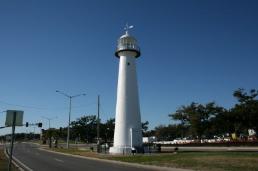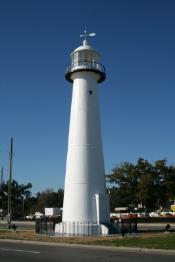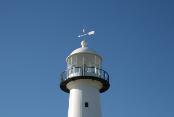

ExploreSouthernHistory.com - Historic Biloxi Lighthouse, Mississippi
ExploreSouthernHistory.com - Historic Biloxi Lighthouse, Mississippi

| Biloxi Lighthouse The historic Biloxi Lighthouse is made of iron and stands in the center of U.S. Highway 90 on the waterfront of Biloxi, Mississippi. |
Biloxi Lighthouse
The beacon of the historic
lighthouse still shines out
nightly, just as it has done
since before the Civil War.
The beacon of the historic
lighthouse still shines out
nightly, just as it has done
since before the Civil War.


Biloxi Lighthouse
The white iron tower of the
historic Biloxi Lighthouse has
survived two of the deadliest
hurricanes in American
history, Camille and Katrina.
The white iron tower of the
historic Biloxi Lighthouse has
survived two of the deadliest
hurricanes in American
history, Camille and Katrina.
Historic Biloxi Lighthouse - Biloxi, Mississippi
Beacon of the Mississippi Coast
| Copyright 2012 by Dale Cox All rights reserved. |


Custom Search


Pre-Civil War Landmark
The Biloxi Lighthouse was
built by the U.S. Government
before the Civil War and its
lantern was extinguished by
Confederate forces. An old
but inaccurate legend holds
that it was painted black when
President Lincoln was
assassinated.
The Biloxi Lighthouse was
built by the U.S. Government
before the Civil War and its
lantern was extinguished by
Confederate forces. An old
but inaccurate legend holds
that it was painted black when
President Lincoln was
assassinated.



Historic Sites in Mississippi
Beauvoir - Home of Jefferson Davis
Fort Massachusetts & Ship Island
Ghost of Deer Island
Singing River of the Mississippi Coast
Biloxi, Mississippi
Historic Sites & Points of Interest
Historic Sites in Mississippi
Explore other Southern Historic Sites
Fort Massachusetts & Ship Island
Ghost of Deer Island
Singing River of the Mississippi Coast
Biloxi, Mississippi
Historic Sites & Points of Interest
Historic Sites in Mississippi
Explore other Southern Historic Sites
The Biloxi Lighthouse is one of the most
unique historic lighthouses in the South. Not
only did it survive the Civil War, it survived two
of the deadliest hurricanes in American
history and even the development of a major
four-lane highway.
Overlooking Mississippi Sound and the Gulf
of Mexico from the waterfront of Biloxi, the
lighthouse stands on an island formed not by
water, but by the east-bound and west-bound
lanes of U.S. 90. It is, in fact, the only
lighthouse in the United States that stands in
the center of a major highway.
Built in 1848, the Biloxi Lighthouse is one of
the oldest cast iron lighthouses in the nation.
While many lighthouses have exterior walls
of stone, brick or even concrete, the white-
painted walls of the Biloxi tower are sheathed
with plates of cast iron.
Forty-five feet tall from its base to its lantern
room, the lighthouse was built at a cost of
$6,347. It originally was part of a complex that
included a keeper's house and related
structures. The strength of its design was
proved in 1860 when a hurricane struck
Biloxi. The tower, however, was not damaged
and in fact continued to operate throughout
the storm.
It was soon darkened however, but not by the
weather. A storm of a different kind erupted
over the country in 1861. The Southern states
seceded from the Union and Mississippi first
became an independent country and then
part of the Confederate States of America.
To prevent its being used by the Union navy
as a navigation landmark, the Biloxi Light
was darkened on June 18, 1861. It remained
dark until the end of the Civil War.
During that time Confederate forces
occupied then abandoned Fort
Massachusetts on Ship Island. It was then
occupied by Union troops and remained in
their hands until the end of the war. The fort
is visible from the top of the lighthouse on
clear days.
The Biloxi Lighthouse returned to service at
the end of the war. It was shining again by
November of 1865.
Persistent legend holds that the tower of the
Biloxi Light was painted black in 1865 as a
show of mourning following the death by
assassination of President Abraham Lincoln.
This story is often repeated in magazines
and articles and was commonly repeated to
tourists in earlier years.
The legend, however, is not true. The
lighthouse tower was painted with tar at the
time it was reactivated following the war to
protect it from rust. Memory of the blackened
look of the tower became joined in later years
with the Lincoln Assassination and a legend
was born.
The Biloxi Lighthouse was painted white in
1868 and has been kept in that color ever
since. It survived another hurricane that
same year, but again continued to shine
through the darkest hours of the storm.
Hurricanes, in fact, have played a major role
in the histories of both Biloxi and its beautiful
lighthouse.
unique historic lighthouses in the South. Not
only did it survive the Civil War, it survived two
of the deadliest hurricanes in American
history and even the development of a major
four-lane highway.
Overlooking Mississippi Sound and the Gulf
of Mexico from the waterfront of Biloxi, the
lighthouse stands on an island formed not by
water, but by the east-bound and west-bound
lanes of U.S. 90. It is, in fact, the only
lighthouse in the United States that stands in
the center of a major highway.
Built in 1848, the Biloxi Lighthouse is one of
the oldest cast iron lighthouses in the nation.
While many lighthouses have exterior walls
of stone, brick or even concrete, the white-
painted walls of the Biloxi tower are sheathed
with plates of cast iron.
Forty-five feet tall from its base to its lantern
room, the lighthouse was built at a cost of
$6,347. It originally was part of a complex that
included a keeper's house and related
structures. The strength of its design was
proved in 1860 when a hurricane struck
Biloxi. The tower, however, was not damaged
and in fact continued to operate throughout
the storm.
It was soon darkened however, but not by the
weather. A storm of a different kind erupted
over the country in 1861. The Southern states
seceded from the Union and Mississippi first
became an independent country and then
part of the Confederate States of America.
To prevent its being used by the Union navy
as a navigation landmark, the Biloxi Light
was darkened on June 18, 1861. It remained
dark until the end of the Civil War.
During that time Confederate forces
occupied then abandoned Fort
Massachusetts on Ship Island. It was then
occupied by Union troops and remained in
their hands until the end of the war. The fort
is visible from the top of the lighthouse on
clear days.
The Biloxi Lighthouse returned to service at
the end of the war. It was shining again by
November of 1865.
Persistent legend holds that the tower of the
Biloxi Light was painted black in 1865 as a
show of mourning following the death by
assassination of President Abraham Lincoln.
This story is often repeated in magazines
and articles and was commonly repeated to
tourists in earlier years.
The legend, however, is not true. The
lighthouse tower was painted with tar at the
time it was reactivated following the war to
protect it from rust. Memory of the blackened
look of the tower became joined in later years
with the Lincoln Assassination and a legend
was born.
The Biloxi Lighthouse was painted white in
1868 and has been kept in that color ever
since. It survived another hurricane that
same year, but again continued to shine
through the darkest hours of the storm.
Hurricanes, in fact, have played a major role
in the histories of both Biloxi and its beautiful
lighthouse.
The October storm of 1893, for example,
washed away a seawall and threatened the
foundations of the tower itself. There were
twin hurricanes in 1916 and 1917, but
despite additional damage to the grounds
and support structures, the tower survived.
In fact, the Biloxi Lighthouse withstood two of
the deadliest hurricanes ever to hit the United
States - Camille and Katrina.
Hurricane Camille slammed into the
Mississippi Gulf Coast on August 17, 1969,
with sustained winds of 190 miles per hour
or more and gusts of more than 220 miles
per hour.
Before it was done, Camille killed roughly
300 people and injured nearly 9,000. More
than 5,000 homes were destroyed. The Biloxi
Lighthouse Survived.
Camille was followed on August 28, 2005, by
Hurricane Katrina. A 28-foot storm surge
roared into Biloxi, destroying an estimated
90% of the buildings along the coastline of
Biloxi and nearby Gulfport. The surge was the
highest ever documented in the United
States. It is believed that 126 people died in
Harrison County, Mississippi, alone.
The Biloxi Lighthouse was damaged, but still
stood. An American flag was draped from its
top and for Mississippians, the tower
became a symbol of survival and rebirth. It
soon adorned Mississippi's license plates.
The lighthouse, like much of the Biloxi
waterfront, has been fully restored. Guided
tours ($5 for adults, $2 for students) are
available Monday through Saturday at 9, 9:15
and 9:30 a.m. No reservations are needed.
The lighthouse is at U.S. 90 and Porter
Avenue. Please click here to learn more.
washed away a seawall and threatened the
foundations of the tower itself. There were
twin hurricanes in 1916 and 1917, but
despite additional damage to the grounds
and support structures, the tower survived.
In fact, the Biloxi Lighthouse withstood two of
the deadliest hurricanes ever to hit the United
States - Camille and Katrina.
Hurricane Camille slammed into the
Mississippi Gulf Coast on August 17, 1969,
with sustained winds of 190 miles per hour
or more and gusts of more than 220 miles
per hour.
Before it was done, Camille killed roughly
300 people and injured nearly 9,000. More
than 5,000 homes were destroyed. The Biloxi
Lighthouse Survived.
Camille was followed on August 28, 2005, by
Hurricane Katrina. A 28-foot storm surge
roared into Biloxi, destroying an estimated
90% of the buildings along the coastline of
Biloxi and nearby Gulfport. The surge was the
highest ever documented in the United
States. It is believed that 126 people died in
Harrison County, Mississippi, alone.
The Biloxi Lighthouse was damaged, but still
stood. An American flag was draped from its
top and for Mississippians, the tower
became a symbol of survival and rebirth. It
soon adorned Mississippi's license plates.
The lighthouse, like much of the Biloxi
waterfront, has been fully restored. Guided
tours ($5 for adults, $2 for students) are
available Monday through Saturday at 9, 9:15
and 9:30 a.m. No reservations are needed.
The lighthouse is at U.S. 90 and Porter
Avenue. Please click here to learn more.